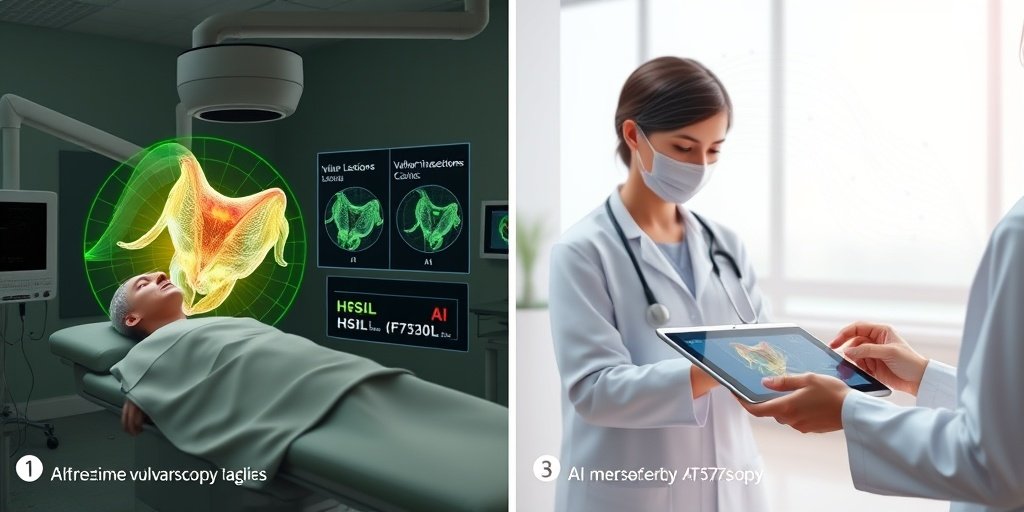⚡ Quick Summary
This groundbreaking study developed the first convolutional neural network (CNN) model for the automatic detection and classification of HPV-related vulvar lesions, achieving an impressive 99.7% sensitivity and 99.1% precision. The integration of AI in vulvoscopy could significantly enhance diagnostic accuracy and improve women’s health outcomes. 🌟
🔍 Key Details
- 📊 Dataset: 28 vulvoscopies, 9,857 annotated frames
- 🧩 Features used: Vulvoscopy images
- ⚙️ Technology: YOLOv11-based object detection model
- 🏆 Performance: Sensitivity 99.7%, Precision 99.1%
🔑 Key Takeaways
- 🤖 AI integration in colposcopy represents a significant advancement in the diagnosis of vulvar lesions.
- 💡 The CNN model is the first of its kind for detecting HPV-related lesions.
- 📈 High performance metrics indicate the model’s reliability in clinical settings.
- 🌍 Potential to reduce the need for invasive procedures in women’s health.
- 🧪 Study conducted across two centers, enhancing the robustness of the findings.
- 📅 Published in the Journal of Clinical Medicine, 2025.
- 🔗 DOI: 10.3390/jcm14197065

📚 Background
The accurate identification of vulvar high-grade squamous intraepithelial lesions (HSIL) is crucial for preventing the progression to invasive squamous cell carcinoma. Traditional diagnostic methods can be subjective and may lead to misdiagnosis, highlighting the need for innovative solutions in women’s health.
🗒️ Study
This bicentric study aimed to bridge the gap in AI applications for vulvar lesion diagnosis. Researchers developed and validated a CNN model to automatically detect and classify HPV-related lesions, specifically HSIL and low-grade squamous intraepithelial lesions (LSIL), using a comprehensive dataset of vulvoscopy images.
📈 Results
The CNN model achieved a remarkable recall of 99.7% and a precision of 99.1% for lesion detection and classification. These results underscore the model’s potential to enhance diagnostic accuracy significantly, paving the way for its integration into clinical practice.
🌍 Impact and Implications
The integration of AI models like this one into vulvoscopy could revolutionize the diagnostic landscape for HPV-related vulvar lesions. By improving accuracy and reducing the need for invasive procedures, this technology has the potential to greatly enhance women’s health outcomes and overall quality of care.
🔮 Conclusion
This study highlights the transformative potential of artificial intelligence in the field of gynecological diagnostics. The development of a CNN model for detecting and classifying HPV-related vulvar lesions marks a significant milestone in women’s health. Continued research and integration of such technologies could lead to better patient outcomes and more efficient healthcare practices.
💬 Your comments
What are your thoughts on the integration of AI in women’s health diagnostics? We would love to hear your insights! 💬 Leave your comments below or connect with us on social media:
Artificial Intelligence and Colposcopy: Detection and Classification of Vulvar HPV-Related Low-Grade and High-Grade Squamous Intraepithelial Lesions.
Abstract
Background/Objectives: Accurate identification of vulvar high-grade squamous intraepithelial lesions (HSIL) is essential for preventing progression to invasive squamous cell carcinoma. This study addresses the gap in artificial intelligence (AI) applications for vulvar lesion diagnosis by developing and validating the first convolutional neural network (CNN) model to automatically detect and classify HPV-related vulvar lesions-specifically HSIL and low-grade squamous intraepithelial lesions (LSIL)-based on vulvoscopy images. Methods: This bicentric study included data from 28 vulvoscopies, comprising a total of 9857 annotated frames, categorized using histopathological reports (HSIL or LSIL). The dataset was divided into training, validation, and testing sets for development and assessment of a YOLOv11-based object detection model. Results: The CNN demonstrated a recall (sensitivity) of 99.7% and a precision (positive predictive value) of 99.1% for lesion detection and classification. Conclusions: This is the first AI model developed for detecting and classifying HPV-related vulvar lesions. The integration of such models into vulvoscopy could significantly improve diagnostic accuracy and positively impact women’s health by reducing the need for potentially invasive and anatomy-altering procedures.
Author: [‘Mascarenhas M’, ‘Sivalingam V’, ‘Castro I’, ‘Jones K’, ‘Martins M’, ‘Alencoão I’, ‘Carinhas MJ’, ‘Mota J’, ‘Cardoso P’, ‘Mendes F’, ‘Almeida MJ’, ‘Mendes B’, ‘Ferreira J’, ‘Macedo G’, ‘Mascarenhas T’, ‘Javed A’, ‘Macedo RZ’]
Journal: J Clin Med
Citation: Mascarenhas M, et al. Artificial Intelligence and Colposcopy: Detection and Classification of Vulvar HPV-Related Low-Grade and High-Grade Squamous Intraepithelial Lesions. Artificial Intelligence and Colposcopy: Detection and Classification of Vulvar HPV-Related Low-Grade and High-Grade Squamous Intraepithelial Lesions. 2025; 14:(unknown pages). doi: 10.3390/jcm14197065